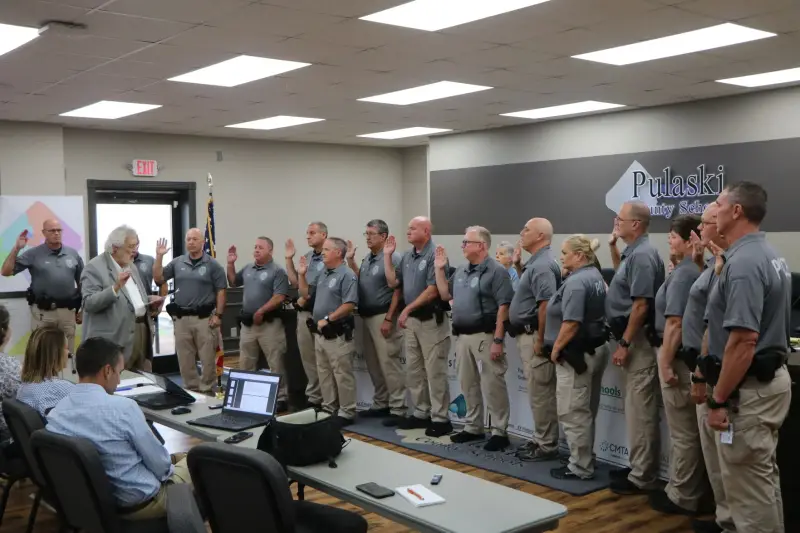By Michael R. Grigsby, Editor | Somerset-Pulaski Advocate

Image Coursty of Puaslki Co. Board of Education..
Somerset, Kentucky (SPA)-- In August 2025, Pulaski County Public Schools officially initiated a School Police Department, marking a significant investment in both school safety and community well-being. This bold step reflects a broader commitment to fostering secure educational environments and building stronger partnerships between students, parents, staff, and law enforcement.
History of the SRO Program in the Pulaski County School District
From 2004 to 2007, Pulaski County utilized the Somerset Police Department (SPD) for School Resource Officers serving schools within the City of Somerset. During this period, the program earned distinction: in 2005 the Kentucky Center for School Safety recognized it as one of four model SRO programs in the Commonwealth, highlighting the initiative’s early quality, interagency coordination, and student-centered practice. (Recognition noted in local program records; KCSS remains the state’s clearinghouse for school safety best practices.)
Expansion and Partnership Years
In the years that followed, the district expanded SRO coverage through contracts with local agencies, with the Pulaski County Sheriff’s Office assigning deputies to Pulaski County High School and middle schools—continuing the prevention-first, relationship-driven approach that distinguished the early model. State expectations and training infrastructure. Kentucky’s school safety framework emphasizes trained SROs, formal contracts/MOUs, and a State School Security Marshal overseeing compliance and risk assessments. DOCJT now provides tiered SRO training (SRO 1–3), including adolescent development, mental-health awareness, and trauma-informed practices.

Image courtesy of Pulaski County Board of Education

Background & Rationale
School safety has long been a priority in the Pulaski County district. Over recent years, the district has collaborated closely with local law enforcement and first responders—hosting realistic active-shooter drills, conducting facility assessments, and implementing security upgrades like cameras and controlled access points. The early development of a school policy concept was performed in the 2004-2005 school year under the COPS in School Funding initiative. The introduction of a formal police department within schools represents a structured evolution from these collaborative models. The original program was named as one of the original four model programs by the Kentucky Center for School Safety.
How the New Department Will Serve Students and the Community
1) Unified Coverage, Faster Coordination. A district force standardizes policies, training rhythms, and daily routines across all campuses while maintaining mutual-aid ties with SPD and PCSO. That coherence reduces hand-offs and response friction, especially during multi-campus events.
2) Prevention First, Policing Rarely. The department will embed the three-role SRO model—educator, mentor, protector—with classroom outreach and restorative, problem-solving approaches prioritized ahead of enforcement. Kentucky practice and KCSS guidance reinforce this balance.
3) High-Fidelity Training. All officers will complete DOCJT’s SRO 1–3 sequence and maintain current certifications (e.g., de-escalation, threat assessment, crisis response). The department’s training plan mirrors state expectations and national best-practice rubrics.
4) Clear Governance and MOUs. The district will maintain a transparent memorandum of agreement that defines roles, student-rights protections, and data-sharing boundaries, consistent with KCSS/DOCJT templates and COPS Office guidance.
5) Measurable Outcomes. The department’s success metrics will include:
-
Response metrics: time to call/contain/resolve;
-
Climate indicators: student/staff surveys on trust and belonging;
-
Prevention outputs: completed safety lessons, family outreach, and tabletop exercises;
-
Equity checks: periodic reviews of referrals, searches, and use-of-force—reported in aggregate to the community.
6) Whole-Community Communication. Regular briefings, campus safety walkthroughs, and parent forums will keep families informed and create feedback loops—an approach reinforced by KCSS’s role as the state’s hub for disseminating effective safety practices. elc.ky.gov
Near-Term Priorities (2025–2026)
-
Staffing to standard. Ensure an officer at every school—a statewide goal Kentucky has backed with increased attention and resources, while preserving flexibility for special events and transport.
-
Threat Assessment + Drills. Align with the School Security Marshal’s risk-assessment tool, conduct scenario-based drills with school teams, and tighten reunification protocols. DOCJT
-
Student-Centered Programming. Expand law-related education (digital citizenship, conflict resolution, safe driving), mentoring circles, and targeted supports for transitions (6th/9th grade). kycss.org
-
Interagency Interoperability. Quarterly joint trainings with SPD and PCSO (radio comms, ICS, campus layouts) to guarantee seamless mutual aid. City of Somerset, Kentucky
The Long View
Superintendent communications have since underscored the goal: consistent coverage at every school by certified police officers with full arrest authority, integrated into the district’s student-safety and attendance priorities. Pulaski County’s school police department isn’t a departure; it’s a maturation of a community ethos that started in 2004—recognized in 2005 as exemplary—and refined through decades of partnership. With professionalized training, transparent governance, and prevention-first policing, the department aims to strengthen safety while deepening trust, ensuring that the district’s campuses remain welcoming places to learn, teach, and work.
******
(C) 2025 Somerset-Pulaski Advocate. All Rights Reserved
Add comment
Comments